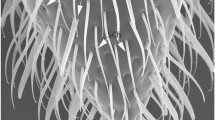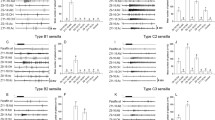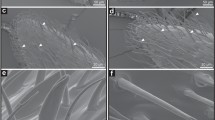Abstract
In comparison to the large amount of study on the communication abilities of females in ant societies and their associated chemical ecology and sensory physiology, such study of male ants has been largely ignored; accordingly, little is known about their olfactory sensory capabilities. To address this, we explored peripheral odor sensitivities in male Harpegnathos saltator by measuring the electrophysiological activity of olfactory sensory neurons within antennal trichoid and coeloconic sensilla using an extracellular recording technique. In an initial trial of 46 compounds, sensilla trichodea responded strongly to two alarm pheromone components, while a limited number of non-hydrocarbon odorants elicited strong responses in sensilla coeloconica. Both sensillar types responded indifferently to 31 cuticular hydrocarbons (CHCs) and synthetic long-chain hydrocarbons (HCs) typically found on insect cuticle. In a search for sensilla responding to CHCs and other compounds, we found some sensilla that responded to synthetic HCs and CHCs from virgin queen postpharyngeal glands that are potentially used in close range mate recognition. Olfactometer bioassays of male ants to 15 non-HCs correlated sensory responsiveness to the respective behavioral responses. Comparing olfactory responses between H. saltator males and females, we found that sensilla coeloconica and basiconica of workers showed greater responses and broader selectivity to all compounds. The rarity of CHC-responding trichoid sensilla in Harpegnathos males suggests a more specific role in sexual communication compared to that in females, which use CHCs in a broader communication context.






Similar content being viewed by others
References
Alonso LE, Vander Meer RK (1997) Source of alate excitant pheromones in the red imported fire ant Solenopsis invicta (Hymenoptera: Formicidae). J Insect Behav 10:541–555
Benton R, Vannice KS, Gomez-Diaz C, Vosshall LB (2009) Variant ionotropic glutamate receptors as chemosensory receptors in Drosophila. Cell 136:149–162. https://doi.org/10.1016/j.cell.2008.12.001
Binyameen M, Anderson P, Ignell R, Seada MA, Hansson BS, Schlyter F (2012) Spatial organization of antennal olfactory sensory neurons in the female Spodoptera littoralis moth: differences in sensitivity and temporal characteristics. Chem Senses:bjs043
Blum MS (1969) Alarm pheromones. Annu Rev Entomol 14:57–80
Blum MS, Ali M, Jones TH, Snelling RR (1994) Identification of a chemical relaeser of alarm behavior for workers of Harpegnathos saltator JERD.[Hymenoptera, Formicidae]. Memorabilia Zool 48:17–22
Crewe D (1973) Ponerine ant secretions: the mandibular gland secretion of Paltothyreus tarsatus Fabr. J Entomol Soc South Afr 37:291–298
Cuvillier-Hot V, Cobb M, Malosse C, Peeters C (2001) Sex, age and ovarian activity affect cuticular hydrocarbons in Diacamma ceylonense, a queenless ant. J Insect Physiol 47:485–493
de Bruyne M, Foster K, Carlson JR (2001) Odor coding in the Drosophila antenna. Neuron 30:537–552. https://doi.org/10.1016/s0896-6273(01)00289-6
do Nascimento RR, Billen J, Morgan ED (1993) The exocrine secretions of the jumping ant Harpegnathos saltator. Comp Biochem Physiol B: Comp Biochem 104:505–508
Ghaninia M, Haight K, Berger SL, Reinberg D, Zwiebel LJ, Ray A, Liebig J (2017) Chemosensory sensitivity reflects reproductive status in the ant Harpegnathos saltator. Sci Rep 7:3732
Haight KL (2012) Patterns of venom production and temporal polyethism in workers of Jerdon's jumping ant, Harpegnathos saltator. J Insect Physiol 58:1568–1574. https://doi.org/10.1016/j.jinsphys.2012.09.011
Hernández JV, Cabrera A, Jaffe K (1999) Mandibular gland secretion in different castes of the leaf-cutter ant Atta laevigata. J Chem Ecol 25:2433–2444
Hölldobler B, Wilson E (1990) The ants. Harvard University Press, Cambridge
Jarvis AP, Liebig J, Hölldobler B, Oldham NJ (2004) Biosynthesis of the insect pheromone (S)-4-methyl-3-heptanone. Chem Commun:1196–1197
Koch SI, Groh K, Vogel H, Hannson BS, Kleineidam CJ, Grosse-Wilde E (2013) Caste-specific expression patterns of immune response and chemosensory related genes in the leaf-cutting ant, Atta vollenweideri. PLoS One 8:e81518. https://doi.org/10.1371/journal.pone.0081518
Leonhardt SD, Brandstaetter AS, Kleineidam CJ (2007) Reformation process of the neuronal template for nestmate-recognition cues in the carpenter ant Camponotus floridanus. J Comp Physiol A 193:993–1000
Liebig J (2010) Hydrocarbon profiles indicate fertility and dominance status in ant, bee, and wasp colonies. In: Blomquist GJ, Bagnères AG (eds) Insect hydrocarbons: biology, biochemistry, and chemical ecology. Cambridge University Press, Cambridge, pp 254–281
Liebig J, Hölldobler B, Peeters C (1998) Are ant workers capable of colony foundation? Naturwissenschaften 85:133–135
Liebig J, Peeters C, Oldham NJ, Markstädter C, Hölldobler B (2000) Are variations in cuticular hydrocarbons of queens and workers a reliable signal of fertility in the ant Harpegnathos saltator? Proc Natl Acad Sci USA 97:4124–4131
Maschwitz U (1964) Gefahrenalarmstoffe und Gefahrenalarmierung bei sozialen Hymenopteren. Zeitschrift für vergleichende Physiologie 47:596–655
Moser JC, Reeve JD, Bento JMS, Della Lucia TM, Cameron RS, Heck NM (2004) Eye size and behaviour of day-and night-flying leafcutting ant alates. J Zool 264:69–75
Nakanishi A, Nishino H, Watanabe H, Yokohari F, Nishikawa M (2010) Sex-specific antennal sensory system in the ant Camponotus japonicus: glomerular organizations of antennal lobes. J Comp Neurol 518:2186–2201. https://doi.org/10.1002/cne.22326
Olivier V, Monsempes C, François MC, Poivet E, Jacquin-Joly E (2011) Candidate chemosensory ionotropic receptors in a Lepidoptera. Insect Mol Biol 20:189–199
Ozaki M, Wada-Katsumata A, Fujikawa K, Iwasaki M, Yokohari F, Satoji Y, Nisimura T, Yamaoka R (2005) Ant nestmate and non-nestmate discrimination by a chemosensory sensillum. Science 309:311–314
Pask GM, Slone JD, Millar JG, Das P, Moreira JA, Zhou X, Bello J, Berger SL, Bonasio R, Desplan C, Reinberg D, Liebig J, Zwiebel LJ, Ray A (2017) Specialized odorant receptors in social insects that detect cuticular hydrocarbon cues and candidate pheromones. Nat Commun 8:297
Peeters C, Monnin T, Malosse C (1999) Cuticular hydrocarbons correlated with reproductive status in a queenless ant. Proc R Soc Lond B Biol Sci 266:1323–1327
Peeters C, Liebig J, Hölldobler B (2000) Sexual reproduction by both queens and workers in the ponerine ant Harpegnathos saltator. Insect Soc 47:325–332
Pitts RJ, Derryberry SL, Zhang ZW, Zwiebel LJ (2017) Variant ionotropic receptors in the malaria vector mosquito Anopheles gambiae tuned to amines and carboxylic acids. Sci Rep 7. https://doi.org/10.1038/srep40297
Pophof B (1997) Olfactory responses recorded from sensilla coeloconica of the silkmoth Bombyx mori. Physiol Entomol 22:239–248
Schettino M, Grasso DA, Weldegergis BT, Castracani C, Mori A, Dicke M, van Lenteren JC, van Loon JJA (2017) Response of a predatory ant to volatiles emitted by aphid-and caterpillar-infested cucumber and potato plants. J Chem Ecol 43:1007–1022
Sharma KR, Enzmann BL, Schmidt Y, Moore D, Jones GR, Parker J, Berger SL, Reinberg D, Zwiebel LJ, Breit B, Liebig J, Ray A (2015) Cuticular hydrocarbon pheromones for social behavior and their coding in the ant antenna. Cell Rep 12:1261–1271
Slone JD et al (2017) Functional characterization of odorant receptors in the ponerine ant, Harpegnathos saltator. Proc Natl Acad Sci 201704647
Tumlinson J, Silverstein R, Moser J, Brownlee R, Ruth J (1971) Identification of the trail pheromone of a leaf-cutting ant, Atta texana. Nature 234:348–349
van Zweden JS, d’Ettorre P (2010) Nestmate recognition in social insects and the role of hydrocarbons. In: Blomquist GJ, Bagnères AG (eds) Insect hydrocarbons: Biology, biochemistry, and chemical ecology. Cambridge University Press, Cambridge, p 222–243
Yan H et al (2017) An engineered orco mutation produces aberrant social behavior and defective neural development in ants. Cell 170:736–747
Yao CA, Ignell R, Carlson JR (2005) Chemosensory coding by neurons in the coeloconic sensilla of the Drosophila antenna. J Neurosci 25:8359–8367. https://doi.org/10.1523/jneurosci.2432-05.2005
Zhou X, Slone JD, Rokas A, Berger SL, Liebig J, Ray A, Reinberg D, Zwiebel LJ (2012) Phylogenetic and transcriptomic analysis of chemosensory receptors in a pair of divergent ant species reveals caste-specific signatures of odor coding. PLoS Genet 8:e1002930. https://doi.org/10.1371/journal.pgen.1002930
Acknowledgments
We thank Kevin Haight (ASU) for assistance with maintaining ant colonies and valuable comments on the first draft of the manuscript. David Lowry (SoLS, Electron Microscopy Laboratory, ASU) is acknowledged for assistance with SEM. Kaustubh Gokhale, Brittany Enzmann, and Kelly Dolezal (ASU) are acknowledged for their assistance and discussion of the experiments.
Author information
Authors and Affiliations
Corresponding author
Electronic supplementary material
ESM 1
(XLS 32 kb)
Rights and permissions
About this article
Cite this article
Ghaninia, M., Berger, S.L., Reinberg, D. et al. Antennal Olfactory Physiology and Behavior of Males of the Ponerine Ant Harpegnathos saltator. J Chem Ecol 44, 999–1007 (2018). https://doi.org/10.1007/s10886-018-1013-6
Received:
Revised:
Accepted:
Published:
Issue Date:
DOI: https://doi.org/10.1007/s10886-018-1013-6




